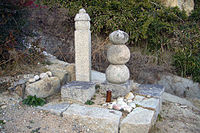Worship of the living (Japanese: 生祀, seishi; Chinese: 生祠, shengci) is the worship of living people practiced in the East Asian cultural sphere. In China, it is practiced at sheng shrines (Chinese: 生祠, Shengci).[1] There are two types of enshrinement: the enshrinement of the spirit of a living person who has made a significant contribution, and the enshrinement of one's own spirit.
Due to the usage by Wei Zhongxian the practice became seen as a sign of corruption and declined in China.[2] In Japan, the practice was most prominent with the worship of the Emperor during the period of the imperial State Shinto from the late 19th century until 1945.[3]

- ^ "为关心民生疾苦而设的生祠,在明代起着什么样的作用?_政治_祭祀_陈天祥". Sohu. 2022-12-18. Archived from the original on 2022-12-18. Retrieved 2023-01-12.
- ^ "生祠并非魏忠贤的专利-凤凰周刊" [Shengci is not Wei Zhongxian's invention]. www.ifengweekly.com. Retrieved 2022-12-22.
- ^ Earhart, H. Byron (1974). Religion in the Japanese experience: sources and interpretations (3rd ed.). Encino, Calif.: Dickenson Pub. Co. ISBN 0822101041.